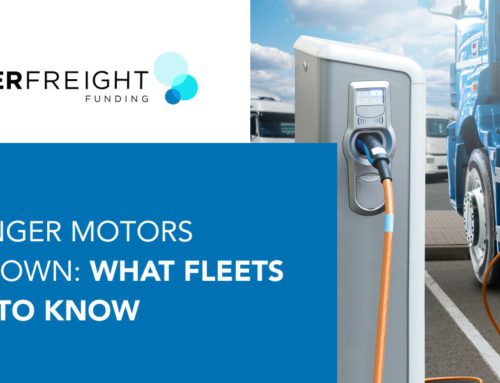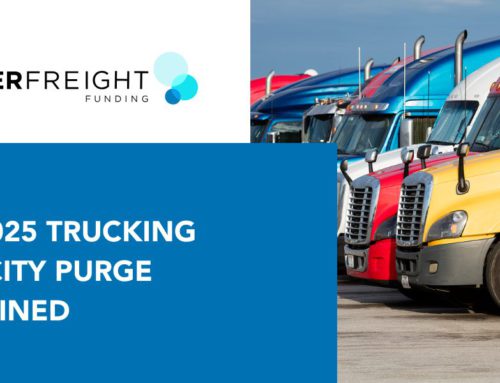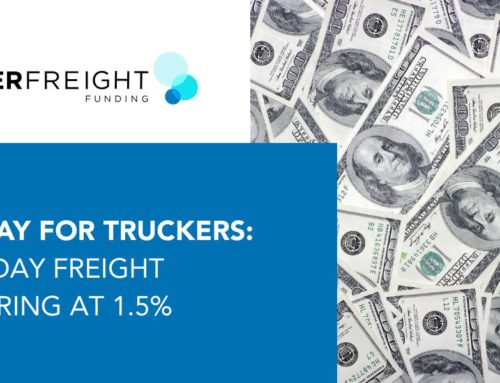If you are or want to become an owner-operator, you’re in good company. The average owner-operator’s annual income ranges from $125,000 to $340,000. The United States transportation and material moving industry is expected to grow faster than average through 2032, with about 1.9 million openings yearly. However, an owner’s expenses may mean they operate within a small profit margin, limiting their earnings.
Jump To Section
It’s critical to manage — and minimize — your business expenses to turn the healthiest profit for your trucking business. By learning your typical expenses with an owner-operator cost breakdown, you can plan for the future and take steps to reduce your costs and maximize your earnings.
#1 – Truck Payments
Owner-operators must choose between leasing and buying their trucks. If an owner-operator owns their truck, they may not need to worry about a monthly payment — once they’ve paid off any financing for their purchase. However, some truckers choose to lease if they’re uncertain about their future in the trucking industry. Others might rent their truck because they prefer seasonal work and want to avoid spending money on their trucks during their “off” season.
Whatever the reason for leasing, an owner-operator’s monthly lease payment is likely to be one of their most significant expenses. Truck lease payments are often one of the largest expenses for operating a truck. Lease amounts may vary based on lease time frame and truck type. According to the American Transportation Research Institute (ATRI), truckers spent an average of $14.46 per hour on their truck or trailer payments in 2023.
However, monthly truck lease payments don’t account for other owner-operator truck driver expenses, including maintenance, insurance and tire fees.
#2 – Preventive Maintenance and Repairs
Truck maintenance and repair costs are also significant expenses for owner-operators. Maintenance costs can vary wildly from year to year, making it more challenging for owner-operators to prepare for those repairs ahead of time. In 2023, truck drivers spent an average of $0.202 per mile on repairs and maintenance. The costs for independent truck drivers are often much higher than those for companies that own a fleet of trucks.
While it contributes to your costs, preventive maintenance is essential. Truckers should never skip scheduling routine maintenance or repairing defects on their vehicle to save money. Missing maintenance could result in costly, unexpected breakdowns or complications with your fleet. Unresolved vehicle defects could also make you liable for an accident and increase your liability insurance premiums, resulting in a harder financial hit in the long term.
Additionally, by law, you must maintain your commercial vehicle so it is safe to operate and keep a detailed record of your truck’s maintenance and repairs.
#3 – Fuel
Fuel is one of the most significant expenses for truck drivers — especially if they travel long distances. Total annual fuel costs are highly variable based on the number of miles you put in, but you can expect to spend tens of thousands of dollars fueling your truck each year. The average truck refueling cost per mile in 2023 was $0.553.
You can estimate how much you’ll spend on fuel by calculating your truck’s average cost per mile. To do this, divide your truck’s average miles per gallon by the current price per gallon of fuel. Multiply this new number by the number of miles you plan to drive to get your truck’s average cost per mile.
If you’re concerned about fuel costs, you’re not alone. The best way to save money on fuel is to find your truck’s engine “sweet spot.” This benchmark refers to the revolutions per minute (RPM) at which it operates most efficiently, using less fuel than it would at other RPMs.
You can also save thousands on fuel annually by signing up for a fuel card. In addition to saving money, fuel cards boast other significant benefits for busy owner-operators. These advantages include fuel advances, real-time fuel expense tracking and streamlined International Fuel Tax Agreement (IFTA) reporting.
#4 – Tolls and Emissions
Like fuel, toll expenses are often unavoidable. In 2023, toll costs averaged about 3 cents per mile. Even with this average, it’s often difficult for truckers to estimate toll expenses. Toll rates vary depending on your vehicle type and weight, payment method and the time of day you’re traveling. The region where you operate is another major contributor to toll costs. Tolls are highest in the Northeast and Midwest.
The good news is that owner-operators can save money on tolls in a few ways. For example, truckers should ensure their vehicle classification is correct before hitting the road to avoid misclassification charges. They can also set up transponder accounts with local tolling agencies such as E-ZPass to receive toll discounts.
Another recurring cost you may encounter is emissions testing or new emissions laws. For example, in California, truck owners must pay annual compliance fees and undergo emissions compliance testing. The annual compliance fee is $30.
#5 – Licensing, Permits and Documentation
Owner-operators must comply with state and federal trucking guidelines and meet interstate and intrastate transport requirements to drive a commercial vehicle. Complying with these laws means paying for various licenses and permits periodically. Be sure to check your local Department of Motor Vehicles to determine which state permits you’ll need for your vehicle. Depending on your vehicle type, you will most likely need a:
- Class A driver’s license: $2-200
- Motor Carrier Operating Authority number: $300
- Unified Carrier Registration: $37
- Commercial liability insurance: $800
- IFTA fuel tax decal: $0 – $10
You may also need a business license, United States Department of Transportation (US DOT) registration number, International Registration Plan plate and state transportation permit. The costs for these items often vary depending on the state. These costs are owner-operator startup costs and ongoing expenses.
To remain compliant, maintain a log of your license or permit details and renewal dates or deadlines. Tracking these details ensures you renew your licenses and permits on time, which is critical.
An expired license or permit could harm your business and wallet. For example, failure to complete the biennial renewal of your Motor Carrier Identification Report MCS-150 could result in the revocation of your vehicle’s US DOT number. Depending on your freight type, you can also incur a civil penalty of up to $1,000 or more per day. These penalties are capped at $10,000.
#6 – Insurance
Yet another significant expense for owner-operators is insurance. There are three primary types of insurance for truckers: vehicle, health and liability insurance. The more coverage you have, the higher your trucking company’s monthly expenses will be. However, less coverage increases your chances of accident liability, which may come with extreme financial responsibilities.
There are many types of commercial truck insurance. Most often, your freight carrier and the type of cargo you’re hauling set the standard for what kind of insurance you’ll need. At a minimum, the Federal Motor Carrier Safety Administration (FMCSA) requires truckers to have proof of general liability insurance.
However, you’ll want to ensure your insurance covers your truck and freight. You might also prefer to have non-trucking liability insurance if you plan to use your truck for non-business purposes. It’s critical to work with a reputable insurance broker that can properly advise you based on your circumstances.
#7 – Taxes
Like other self-employed persons, taxes are not automatically deducted for solo over-the-roaders. Instead, independent truckers must track their business expenses with the 1040-ES form and pay quarterly taxes. These taxes include:
- Self-employment
- Federal income
- State income
- Social Security
- Medicare
The self-employment tax rate is 15.3%, 12.4% for Social Security and 2.9% for Medicare. In addition to self-employment tax, you must pay quarterly federal and state income taxes, often about 20 to 30%, depending on your income. If you employ other operators, you must also pay employment taxes.
Owner-operators also qualify for certain deductions and credits to minimize tax liability. Any expense that is “ordinary and necessary” for your business is considered tax deductible by the Internal Revenue Service. These deductions include but aren’t limited to:
- Meals
- Truck payments
- Fuel
- Accounting or bookkeeping fees
- Office supplies
- Insurance
- Maintenance
That said, you must be able to prove your business expenses to qualify for deductions and prepare for potential audits. For this reason, it’s important to hold onto your receipts and track your expenses diligently. If you’re new to self-employed taxes, it’s best to consult a certified public accountant or attorney before tax season. An experienced professional can help you avoid overpaying and identify possible deductions to help you save as much as possible.
#8 – Food and Drink
You will inevitably get hungry on the road, which is why food and drink make our list of the top owner-operator truck driver expenses. Luckily, owner-operators can deduct a portion of their daily business lodging and meal expenses from their taxes under the Per Diem Rate. As of October 2023, the per diem rate for those in the transportation industry traveling within the continental United States is $69 per day. For those working outside of the continental U.S., the per diem rate is $74.
Invest in reusable utensils, a small refrigerator and a microwave to save money on food and drink expenses. You’ll also want to stock up on dry foods — such as granola bars and oatmeal cups — for those times when you need a bite to eat but don’t require a full meal. Having food on hand saves you money and keeps you on schedule.
#9 – Professional Services
Owner-operators rely on a number of products and services to streamline operations and save money in the long term. For example, many truckers partner with freight dispatch companies to find hauling jobs and build connections with reliable brokers, while others use freight factoring services to control and improve company cash flow. Still, others pay monthly subscriptions for load boards and transportation management systems like ITS Dispatch to streamline invoice creation and IFTA reporting.
The Importance of Managing Expenses
While owner-operators have expansive earning potential, they also operate on fairly low profit margins. You can maximize your earnings by tracking and working to lower your expenses.
Partner With Porter Freight Funding for Improved Cashflow and Long-Term Savings
Take control of your owner-operator business expenses and save money in the long term by partnering with Porter Freight Funding. We offer a variety of professional services owner-operators need to find high-paying jobs and run a profitable trucking business. From saving money on fuel with an EFS Fuel Network fuel card to getting paid faster with our freight bill factoring services, we’re your one-stop shop for improved cash flow and long-term savings.
Contact us online today or call 205-397-0934 to learn more about our professional trucking services.
Utilize Our Profit/Loss Calculator Today
To get started, you’ll need to input the following variables:
- Load Value: The monetary value of the freight you carry.
- Distance: The total distance, in miles, required to deliver the load from origin to destination.
- Average MPG (Miles Per Gallon): Your fleet’s average fuel consumption for the journey.
- Average price per gallon: The average cost of diesel per gallon.




